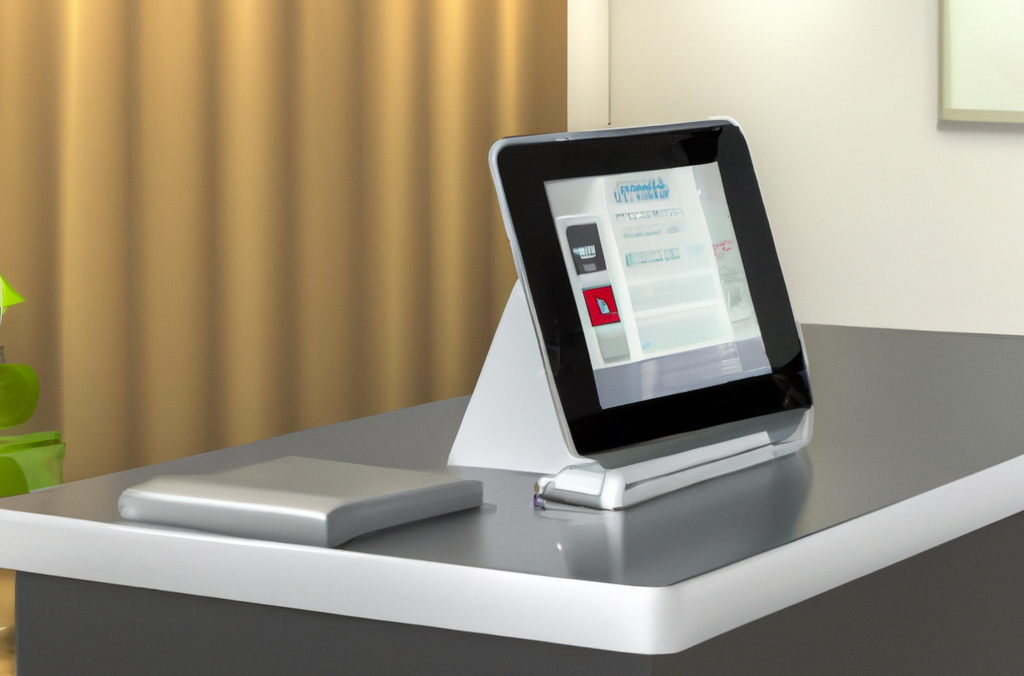Text Messages: An Essential Element of Modern Visitor Management

Visitor management, like our everyday communication and our workplaces, has evolved tremendously over the last 50 years. Fifty years ago, how many imagined you could just as easily sit on a beach or coffee shop with a computer as in an office? It is likely even fewer people dreamed we’d be carrying computers around in our pockets. (In case you missed it, your smartphone is a computer more powerful than what got NASA to the moon, and maybe even better than the best desktop or laptop five years ago.) Those mini-computers have changed our lives in a huge number of ways, with text messages as one large factor in changing communications. Just as texting has become an essential part of the lives of most adults in the developed world, text messaging needs to be a part of your visitor management plan.
Where We Were
In order to understand just how vital text messages are to modern visitor management, we first need to understand how visitor management itself has evolved with our workplaces.
Once upon a time, offices were fairly formal places. Most employees were out of sight of the main entrance, sequestered away in private or shared offices. Visitors were greeted by a dedicated receptionist. The receptionist would pick up a telephone – attached to a cord! – and place a call to the person who was expecting the visitor or the delivery. The host would ask the receptionist to “send them up,” at which point the visitor would either be allowed to wander freely through the building to find their host, or the receptionist would escort them.
This system was never perfect. The host may have been on another call or not have been at their desk – meetings, after all, have probably been occurring since the dawn of time. At this point, the receptionist might have to ask the guest to wait and place the call again in a few minutes. However, it was unlikely the receptionist had too many other tasks to do, so chatting with the guest may have been a welcome distraction.
Fast Forward to Today
Modern offices are a completely different environment, both for visitors and for employees. Corporations and organizations of all sizes embraced the open office floor plan, eliminating walls. Visitors, instead of walking in to find a single, friendly receptionist, are greeted with a vast array of desks, workstations, cafe seating, and more. Where does a visitor – who is completely unfamiliar with the building, the layout of desks, and the work environment – turn to for help?
Chances are, the unofficial “receptionist” is the unfortunate person who either was assigned to or chose to sit at the desk nearest the door. This person’s work gets interrupted time and time again as delivery personnel, clients, candidates, visitors from all walks of organizational life filter through the entrance and asks for assistance.
Open offices – especially those that, like some coworking locations, allow employees to choose their seats – don’t often lend themselves to easily giving directions. Either the unofficial receptionist has to call or otherwise contact the visitor’s host, or physically lead the guest to where the host is stationed for the day. This can take a tremendous amount of time and effort on the part of the employee.
What happens if the host is not easily found? What if he or she has hidden in a tucked-away corner for the day? Imagine if the employee has to ask every other person in the office if they have seen the host, and where they have seen them. How many people have to be distracted in order to connect the guest with their host? Think what the pizza delivery person must be thinking: “I just want to drop off this pizza, get paid, and get on my way. Where the heck is the person who ordered it?”
While it is certainly possible for a person to text the host, unless the employee has access to the host’s cell number, this may not be possible. This is where the beauty of electronic visitor registration systems really shines.
 Visitor Registration and Contacting the Host
Visitor Registration and Contacting the Host
Visitor registration apps, or visitor management systems, work by having a standard way that visitors are greeted, checked in, and dispatched to their respective hosts. Electronic visitor management systems allow either a receptionist or the visitors themselves to enter the visitor’s contact information. This would include:
- Visitor’s name
- Contact information (phone, email, etc) as necessary
- Reason for visiting
- Host/Person being met
Often, when people consider visitor management systems, they think of them as a way of keeping accurate records. This is a primary benefit that includes records of who visited the office on what days and what the check-in and check-out times were. Depending on the type of business your organization is in, this information can be vital for following legal guidelines, important for security purposes, or simply nice to have as fodder for analysis.
However, some modern visitor management systems come with the incredible benefit of being able to automatically contact a visitor’s host upon the visitor checking in. This eliminates a lot of running around or calling around by a receptionist or any other employee.
Even better, all the employees at the organization can enter their contact preferences into the registration system’s database. This means that those employees who wish to be contacted first by phone, then by text, then by email can set up those parameters right in the system that will do the contacting. Unlike a receptionist or an employee, the digital system can look up the contact information and preferences in microseconds, and electronically carry out the appropriate tasks to get the employee contacted.
Evolution of Communication
If formal receptionists and private offices are less common, belonging more to the past, and open offices and flex workspaces with visitor check-in kiosks are the waves of the future, what is the modern way to connect guests with hosts? Perhaps we should look at the history of communication to determine what communication style is essential to modern employees.
Alexander Graham Bell invented the telephone in 1876. The first email was sent in 1971. and the first text message sent in 1992. According to the Pew Research Company, a full 97% of smartphone users use text messaging, making it the most widely-used feature on devices.
While email and phone calls are certainly not dead communications, there are definitely advantages to text messaging (SMS) that email and phone cannot compete with, especially when it comes to short, urgent messages, like that of notifying a host of a visitor’s arrival.
- Real-time reception notifications. Text messaging is fast, so fast it is nearly instantaneous. Texts rely on cellular rather than internet connectivity.
- Checked quickly. Most smartphone users will check their phones for text messages immediately upon hearing the notification sound. While this can certainly be problematic in meetings, the information that an important guest has arrived can be read so quickly it is much less likely to become an even larger distraction.
- Mobility matters. Unlike phone calls or emails, which are often tied to desks and workstations, smartphones are much more likely to be on the employee’s person. This means that messages meant to connect guests with hosts can reach the host wherever the host is: a meeting, on lunch break, walking down a hallway or sitting at their desks.
- Less distracting. Yes, a text message is distracting. A text message received while in a meeting or having a conversation with a friend will draw your attention away from the conversation for a moment. But unlike an email, which has to be found in a distracting inbox, or a phone call, which causes a separate conversation entirely, a text can be read quickly and relatively unobtrusively. A person who receives a text is less likely to be distracted by other emails, and more likely to quickly and politely excuse themselves in order to greet a guest.
Given the advantages and the popularity of text messages, it is important that, when choosing a digital visitor management system, text messaging capabilities are part of the criteria you consider. Systems that have the ability to contact hosts via text message will have an obvious advantage over those that don’t.
Phone and email (and Slack) Have their places
Since digital visitor management systems allow each employee to set their own reception notification preferences, phone calls, email, and instant messaging services may very well be some employees’ contact methods of choice. While they are not realistic communication choices for every employee, there is a reason the best of these systems let employees choose their own preferences. Only having one contact method – email, phone, or text – is bound to fall completely flat for some segment of your employee population.
Let’s look at the pros and cons of phone and email as a method for informing hosts of a visitor’s arrival. This is important as you consider systems, because some systems may limit you to only phone or email notifications.
Phone call advantages:
- You know the phone is ringing, right now.
- Hard to miss. A ringing or vibrating phone is a persistent message delivery system.
- Great for desk jobs. Any employee tied to a desk is highly likely to receive a phone call, unless they are on the phone or away at the time of the call. Even in this case, many people have call-waiting or other call-routing technologies.
Phone call disadvantages:
- Location Specific. Employee may be away from a desk phone and miss the call altogether, whether at a meeting, lunch break, or another such task.
- Unwelcome Interruptions. Cell phones ringing may not be at all welcome in meetings or other locations. Ringing phones, at any time, are relentless and distracting, often disturbing more than just the person the call is intended for.
Email advantages:
- It is common. Nearly everyone has and receives an email.
- Great for long-form. An email can contain a lot of important information.
- Can be less distracting. Depending on how the employee has email notifications set up on their device, they may be able to receive a short email almost instantly and read it.
Email disadvantages:
As a method for contacting hosts of a visitor’s arrival, email has a lot more drawbacks than it might seem at first glance.
- Slow, compared to other digital communications. WiFi can be notoriously spotty, and some people’s internet connections are slower than others. Emails can take precious seconds, and sometimes minutes, to show up in an inbox. That is time the visitor is stuck waiting.
- SPAM, SPAM, SPAM. Email can get caught by all sorts of various filters, meaning an email sent by an electronic system may never even arrive in a host’s inbox. Even if it does arrive and is read, it may now be spam itself that has to be deleted.
- Workstation dependent. Not all employees have business emails routed to their smartphones. If an employee is only using a laptop or desktop computer to access email, if they are away from their desk or their device, the message will not be noticed in a timely manner.
- Inboxes are “noisy.” By noisy, we aren’t referring to the dings, plonks, and beeps made when a new message arrives – though those can be kind of annoying. Rather, we are referring to the visual “noise” that greets the eye when an inbox is opened. Emails have a tendency to pile up. Just like looking at a messy desk, an email inbox can be a place where important messages get easily lost amid all the rest of the messages that arrive.
- Noise is distracting. Because a single email announcing the arrival of a visitor is nestled among all the other messages that have come in during the day, week, or even month, it is quite possible for the host’s eye to fall upon a much more distracting or urgent message. This could pull the host away from another task.
- Checked less frequently. Unlike a phone call or text message, which are checked nearly instantly, people often silence notifications for email messages for the exact reasons just mentioned above. They know their inboxes are filled with different things vying for their attention. Getting sucked into each one takes time, and thus people will often set a designated time for checking and attending to email.
All of these different issues make email a relatively poor way to contact a host to announce a visitor’s arrival. A phone call is still very effective, for the right employees.
Conclusion: Choosing a visitor management system
The digital visitor management system that has the capability to contact hosts in a variety of ways will be the one that best accomplishes the goal of connecting host and visitor. A good system will have the capability to use texting, phone calls, and email. Some will even include Slack notifications and more. You will NOT want to select a system that only has email capabilities, or only does so within your budget.
When choosing a system, take the time to review not only the system’s capabilities but the payment plan options as well. While a system may be capable of text messaging, it may not be included in certain pricing plans.
In the end, it is about getting visitors to your hosts as quickly and efficiently as possible. Doing so requires moving into the modern world and connecting people using the best technology available.





